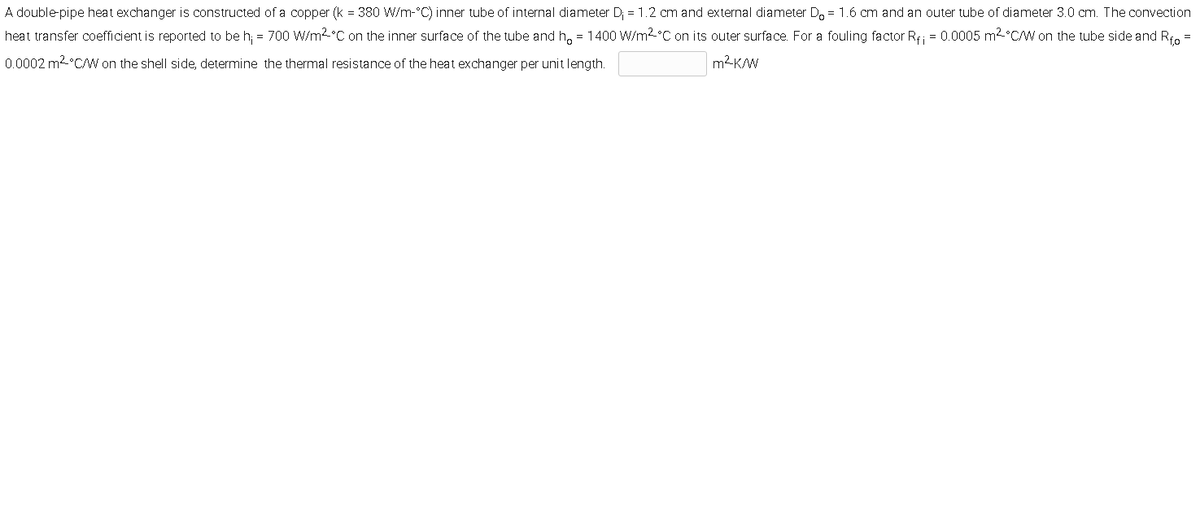A double-pipe heat exchanger is constructed of a copper (k = 380 W/m-°C) inner tube of internal diameter D; = 1.2 cm and external diameter D. = 1.6 cm and an outer tube of diameter 3.0 cm. The convection heat transfer coefficient is reported to be h; = 700 W/m2°C on the inner surface of the tube and h, = 1400 W/m2°C on its outer surface. For a fouling factor Rf; = 0.0005 m2 C/W on the tube side and Rio = 0.0002 m2°CW on the shell side, determine the thermal resistance of the heat exchanger per unit length. m2-KAW
A double-pipe heat exchanger is constructed of a copper (k = 380 W/m-°C) inner tube of internal diameter D; = 1.2 cm and external diameter D. = 1.6 cm and an outer tube of diameter 3.0 cm. The convection heat transfer coefficient is reported to be h; = 700 W/m2°C on the inner surface of the tube and h, = 1400 W/m2°C on its outer surface. For a fouling factor Rf; = 0.0005 m2 C/W on the tube side and Rio = 0.0002 m2°CW on the shell side, determine the thermal resistance of the heat exchanger per unit length. m2-KAW
Principles of Heat Transfer (Activate Learning with these NEW titles from Engineering!)
8th Edition
ISBN:9781305387102
Author:Kreith, Frank; Manglik, Raj M.
Publisher:Kreith, Frank; Manglik, Raj M.
Chapter7: Forced Convection Inside Tubes And Ducts
Section: Chapter Questions
Problem 7.46P
Related questions
Concept explainers
Heat Exchangers
Heat exchangers are the types of equipment that are primarily employed to transfer the thermal energy from one fluid to another, provided that one of the fluids should be at a higher thermal energy content than the other fluid.
Heat Exchanger
The heat exchanger is a combination of two words ''Heat'' and ''Exchanger''. It is a mechanical device that is used to exchange heat energy between two fluids.
Question

Transcribed Image Text:A double-pipe heat exchanger is constructed of a copper (k = 380 W/m-°C) inner tube of internal diameter D; = 1.2 cm and external diameter D, = 1.6 cm and an outer tube of diameter 3.0 cm. The convection
heat transfer coefficient is reported to be h; = 700 W/m2°C on the inner surface of the tube and h, = 1400 W/m2°C on its outer surface. For a fouling factor Rf; = 0.0005 m2°CW on the tube side and Rio =
0.0002 m2°C/W on the shell side, determine the thermal resistance of the heat exchanger per unit length.
Expert Solution
This question has been solved!
Explore an expertly crafted, step-by-step solution for a thorough understanding of key concepts.
Step by step
Solved in 2 steps with 1 images

Knowledge Booster
Learn more about
Need a deep-dive on the concept behind this application? Look no further. Learn more about this topic, mechanical-engineering and related others by exploring similar questions and additional content below.Recommended textbooks for you

Principles of Heat Transfer (Activate Learning wi…
Mechanical Engineering
ISBN:
9781305387102
Author:
Kreith, Frank; Manglik, Raj M.
Publisher:
Cengage Learning

Principles of Heat Transfer (Activate Learning wi…
Mechanical Engineering
ISBN:
9781305387102
Author:
Kreith, Frank; Manglik, Raj M.
Publisher:
Cengage Learning